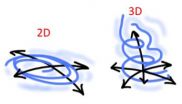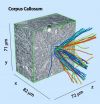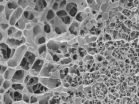(Press-News.org) Biologists record increasing amounts of plastic litter in the Arctic deep sea: studies confirm that twice as much marine debris is lying on the seabed today compared to ten years ago
Bremerhaven, 22nd October 2012. The seabed in the Arctic deep sea is increasingly strewn with litter and plastic waste. As reported in the advance online publication of the scientific journal Marine Pollution Bulletin by Dr. Melanie Bergmann, biologist and deep-sea expert at the Alfred Wegener Institute for Polar and Marine Research in the Helmholtz Association. The quantities of waste observed at the AWI deep-sea observatory HAUSGARTEN are even higher than those found in a deep-sea canyon near the Portuguese capital Lisbon.
For this study Dr. Melanie Bergmann examined some 2100 seafloor photographs taken near HAUSGARTEN, the deep-sea observatory of the Alfred Wegener Institute in the eastern Fram Strait. This is the sea route between Greenland and the Norwegian island Spitsbergen. "The study was prompted by a gut feeling. When looking through our images I got the impression that plastic bags and other litter on the seafloor were seen more frequently in photos from 2011 than in those dating back to earlier years. For this reason I decided to go systematically through all photos from 2002, 2004, 2007, 2008 and 2011," Melanie Bergmann explains.
The deep-sea scientists from the HGF-MPG Group for Deep-Sea Ecology and Technology of the Alfred Wegener Institute regularly deploy their towed camera system OFOS (Ocean Floor Observation System) during Polarstern expeditions to the HAUSGARTEN. At the central HAUSGARTEN station it is towed at a water depth of 2500 metres, 1.5 metres above the seabed, and takes a photograph every 30 seconds. Deep-sea biologists principally use these photographs to document changes in biodiversity with respect to larger inhabitants such as sea cucumbers, sea lilies, sponges, fish and shrimps. However, for Melanie Bergmann they also provided evidence of increasing deep-sea pollution: "Waste can be seen in around one percent of the images from 2002, primarily plastic. In the images from 2011 we made the same discovery on around two percent of the footage. The quantity of waste on the seabed has therefore doubled", the scientist says. If we consider the time span between 2007 and 2011 the amount has even risen by an order of magnitude.
At first sight, the "two percent" result may not cause much concern. However a comparison demonstrates the true extent of the pollution in the Arctic deep sea: "The Arctic Ocean and especially its deep-sea areas have long been considered to be the most remote and secluded regions of our planet. Unfortunately, our results refute this notion at least for our observatory. The quantities observed were higher than those recorded from a deep-sea canyon not far from the industrialised Portuguese capital Lisbon," Melanie Bergmann explains. It is also important to bear in mind that, according to recent research, more plastic waste will accumulate in deep-sea canyons than in open slope environments such as HAUSGARTEN.
Melanie Bergmann is unable to determine the origin of litter from photographs alone. However she suspects that the shrinking and thinning of the Arctic sea ice may play an important role. "The Arctic sea ice cover normally acts as a natural barrier, preventing wind blowing waste from land out onto the sea, and blocking the path of most ships. Ship traffic has increased enormously since the ice cover has been continuously shrinking and getting thinner. We are now seeing three times the number of private yachts and up to 36 times more fishing vessels in the waters surrounding Spitsbergen compared to pre-2007 times," Melanie Bergmann says. Furthermore, litter counts made during annual clean-ups of the beaches of Spitsbergen have shown that the litter washed up there originates primarily from fisheries.
The main victims of the increasing contamination of the seafloor are the deep-sea inhabitants. "Almost 70 percent of the plastic litter that we recorded had come into some kind of contact with deep-sea organisms. For example we found plastic bags entangled in sponges, sea anemones settling on pieces of plastic or rope, cardboard and a beer bottle colonised by sea lilies," Melanie Bergmann says.
When sponges or other suspension feeders come into contact with plastic, this may cause injuries to the surface of their body. The consequence: the inhabitants of the sea bed are able to absorb fewer food particles, grow more slowly as a result, and probably reproduce less often. Breathing could also be impaired. Furthermore, plastic always contains chemical additives, which have various toxic effects. "Other studies have also revealed that plastic bags that sink to the seafloor can alter the gas exchange processes in this area. The sediment below then becomes a low oxygen zone, in which only few organisms survive," Melanie Bergmann says. On the other hand, other animals use the waste as hard substratum to settle on. "This allows colonisation by species that previously would have found hardly any suitable substratum. This means that the waste could change the deep-sea composition of species and therefore biodiversity in the long-term," the researcher adds.
In view of the far-reaching climate changes in the Arctic, Melanie Bergmann and colleagues want to expand their research projects on "litter in the sea": "Until now our results from the Fram Strait merely constitute a snapshot, reflecting the observations that we were able to make with the naked eye," the scientist explains. For example, the focus is currently moving to the question of deep-sea pollution resulting from so-called micro-plastic particles. "We took samples for the first time during the last expedition with our research ice breaker POLARSTERN to the HAUSGARTEN observatory. Our AWI colleagues from Helgoland will analyse them for micro-plastics," says Melanie Bergmann. Micro-plastics can be ingested by marine animals including commercially harvested prawns and fish and enter the human food chain.
During this expedition Belgian mammal and bird observers also counted 32 pieces of litter floating at the water surface. The probability of researchers finding more litter on the deep ocean floor is therefore great. Melanie Bergmann: "Pieces of plastic on the deep seafloor are unlikely to degrade into micro-plastics as quickly as is the case on the North Sea coast, for example. This is due to the lack both of sunlight at a depth below 200 metres and of strong water movement. Instead it is dark and cold there. Under these conditions plastic waste can probably persist for centuries."
### Glossary:
HAUSGARTEN: HAUSGARTEN is the deep-sea observatory of the Alfred Wegener Institute in the eastern Fram Strait. It consists of 16 stations covering water depths of between 1000 and 5500 metres. Since 1999 samples were taken annually at these stations every year during the summer months. The year-round deployment of moorings and free-falling systems that act as observation platforms on the sea bed enables seasonal measurements. A remotely controlled underwater vehicle (Remotely Operated Vehicle, ROV) takes targeted samples, positions and services automatic measuring instruments and conducts experiments in situ on a regular basis. HAUSGARTEN is one of the key regions in the European Network of Excellence ESONET (European Seas Observatory Network) and is a member of the German Long Term Ecological Research Network (LTER-D).
Microplastic particles: microplastic particles denote microscopically small plastic particles that are created when plastic waste breaks down into ever smaller fragments during the course of chemical and physical aging processes. Due to their size, microplastics pose a risk of being eaten by small shrimps, fish larvae and other organisms at the bottom of the food chain. For example microplastics have already been found in the stomachs of commercially fished Norwegian lobster. In addition to the pure physical damage, the absorption and concentration of pollutants from the microplastic particles is to be anticipated. No studies have so far looked into the effect of this on the individual organism and on other components of the food chain, however negative consequences are to be feared.
Biologists record increasing amounts of plastic litter in the Arctic deep sea
Studies confirm that twice as much marine debris is lying on the seabed today compared to 10 years ago
2012-10-23
ELSE PRESS RELEASES FROM THIS DATE:
Next-generation vaccines -- eliminating the use of needles
2012-10-23
Lead scientist Professor Simon Cutting, from the School of Biological Sciences at Royal Holloway, has developed the jabs through the use of probiotic spores. He carried out fundamental studies into the biology of the bacterium Bacillus subtilis which attracted the attention of microbiologists due to its ability to form spores that can last millions of years before germinating under the appropriate environmental conditions.
Professor Cutting says: "The mechanisms by which this process occurs have fascinated microbiologists for decades making it one of the most intensively ...
Turbulent flows in 2D can be calculated in new model
2012-10-23
Turbulent flows have challenged researchers for centuries. It is impossible to predict chaotic weather more than a week in advance. Wind resistance on a plane or a car cannot be calculated precisely, since it is determined by atmospheric turbulence. Now, however, researchers from the Niels Bohr Institute have succeeded in developing a statistical model that can replicate the chaotic flows and thereby provide a better understanding of the process. The research results are published in the scientific journal, Physics of Fluids.
"Without knowing the movements in detail, we ...
Quantum computing with recycled particles
2012-10-23
A research team from the University of Bristol's Centre for Quantum Photonics (CQP) have brought the reality of a quantum computer one step closer by experimentally demonstrating a technique for significantly reducing the physical resources required for quantum factoring.
The team have shown how it is possible to recycle the particles inside a quantum computer, so that quantum factoring can be achieved with only one third of the particles originally required. The research is published in the latest issue of Nature Photonics.
Using photons as the particles, the Bristol ...
A circuit diagram of the mouse brain
2012-10-23
This press release is available in German.
What happens in the brain when we see, hear, think and remember? To be able to answer questions like this, neuroscientists need information about how the millions of neurons in the brain are connected to each other. Scientists at the Max Planck Institute for Medical Research in Heidelberg have taken a crucial step towards obtaining a complete circuit diagram of the brain of the mouse, a key model organism for the neurosciences. The research group working with Winfried Denk has developed a method for preparing the whole mouse ...
Lung mucus gel scaffold prevents nanoparticles from getting through
2012-10-23
Mucus coats our airways' internal surfaces. The viscous gel humidifies the lungs and prevents viruses and other small particles like diesel soot from entering the body unchecked. Previously unclear was the extent to which such nanoparticles are able to move through the lungs' mucus. Here, the research evidence was contradictory. Scientists could not explain why, in inhaled medication development, drug nanoparticles often simply got stuck in the mucus never making it to their target destination inside the lung cells.
Now, as part of a German Research Foundation (DFG)-funded ...
The complex association between moderate alcohol consumption and breast cancer
2012-10-23
An excellent review article from two scientists at the National Institute on Alcohol Abuse and Alcoholism in the USA to be published in Alcohol Clin Exp Res 2012, describes the epidemiologic and basic scientific evidence linking alcohol consumption to the risk of breast cancer.
The authors point out deficiencies in the epidemiologic data, especially that the pattern of drinking (regular moderate versus binge drinking) has generally not been taken into consideration, important given that binge drinking is associated with much higher blood alcohol concentrations and acetaldehyde ...
TIM and TAM: 2 paths used by the Dengue virus to penetrate cells
2012-10-23
By demonstrating that it is possible to inhibit the viral infection in vitro by blocking the bonding between the virus and these receptors, the researchers have opened the way to a new antiviral strategy. These works were published on line in the review "Cell Host & Microbe" of October 18, 2012.
The Dengue virus circulates in four different forms (four serotypes). It is transmitted to humans by mosquitoes. It is a major public health problem. Two billion people throughout the world are exposed to the risk of infection and 50 million cases of Dengue fever are recorded by ...
19 species of ferns named for Lady Gaga
2012-10-23
DURHAM, N.C. -- Pop music megastar Lady Gaga is being honored with the name of a new genus of ferns found in Central and South America, Mexico, Arizona and Texas. A genus is a group of closely related species; in this case, 19 species of ferns will carry the name Gaga.
At one stage of its life, the new genus Gaga has somewhat fluid definitions of gender and bears a striking resemblance to one of Gaga's famous costumes. Members of the new genus also bear a distinct DNA sequence spelling GAGA.
Two of the species in the Gaga genus are new to science: Gaga germanotta from ...
Moffitt researchers study how patterns, timing of sunlight exposure contribute to skin cancers
2012-10-23
Researchers at Moffitt Cancer Center, the University of South Florida and the International Agency for Research on Cancer in France have studied the patterns and timing of sunlight exposure and how each is related to two nonmelanoma skin cancers – basal cell carcinoma and squamous cell carcinoma.
This study, published in the open-access journal BioMed Central, is the first case-control study to simultaneously evaluate identical patterns and timing of sunlight exposure as they are related to basal cell and squamous cell carcinomas in the same U.S. population with high ...
Vanderbilt researchers find that diabetes drug could be effective in treating addiction
2012-10-23
Vanderbilt researchers are reporting today that a drug currently used to treat type 2 diabetes could be just as effective in treating addiction to drugs, including cocaine.
The findings, published online today as a Letter To The Editor in the journal Molecular Psychiatry, could have far-reaching implications for patients worldwide who suffer from addiction.
"What we have demonstrated is that a brain mechanism already known to be therapeutic for the treatment of diabetes also appears to be implicated in at least certain types of drug addiction," said Gregg Stanwood, ...
LAST 30 PRESS RELEASES:
This new understanding of T cell receptors may improve cancer immunotherapies
A new fossil face sheds light on early migrations of ancient human ancestor
A new immunotherapy approach could work for many types of cancer
A new way to diagnose deadly lung infections and save lives
40 percent of MRI signals do not correspond to actual brain activity
How brain-inspired algorithms could drive down AI energy costs
Gum disease may be linked to plaque buildup in arteries, higher risk of major CVD events
Contrails are a major driver of aviation’s climate impact
Structure of dopamine-releasing neurons relates to the type of circuits they form for smell-processing
Reducing social isolation protects the brain in later life
Keeping the heart healthy increases longevity even after cancer
Young adults commonly mix cannabis with nicotine and tobacco
Comprehensive review illuminates tau protein's dual nature in brain health, disease, and emerging psychiatric connections
Book prepares K-12 leaders for the next public health crisis
Storms in the Southern Ocean mitigates global warming
Seals on the move: Research reveals key data for offshore development and international ecology
Sports injuries sustained during your period might be more severe
World's first successful 2 Tbit/s free-space optical communication using small optical terminals mountable on satellites and HAPS
Can intimate relationships affect your heart? New study says ‘yes’
Scalable and healable gradient textiles for multi‑scenario radiative cooling via bicomponent blow spinning
Research shows informed traders never let a good climate crisis go to waste
Intelligent XGBoost framework enhances asphalt pavement skid resistance assessment
Dual-function biomaterials for postoperative osteosarcoma: Tumor suppression and bone regeneration
New framework reveals where transport emissions concentrate in Singapore
NTP-enhanced lattice oxygen activation in Ce-Co catalysts for low-temperature soot combustion
Synergistic interface engineering in Cu-Zn-Ce catalysts for efficient CO2 hydrogenation to methanol
COVID-19 leaves a lasting mark on the human brain
Scientists use ultrasound to soften and treat cancer tumors without damaging healthy tissue
Community swimming program for Black youth boosts skills, sense of belonging, study finds
Specific depressive symptoms in midlife linked to increased dementia risk
[Press-News.org] Biologists record increasing amounts of plastic litter in the Arctic deep seaStudies confirm that twice as much marine debris is lying on the seabed today compared to 10 years ago


